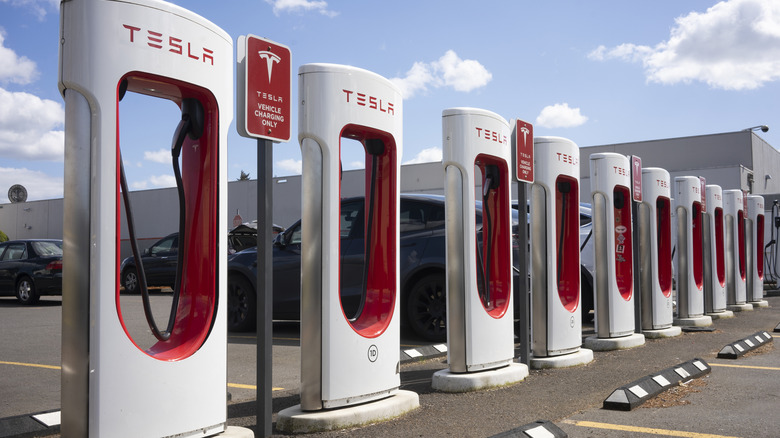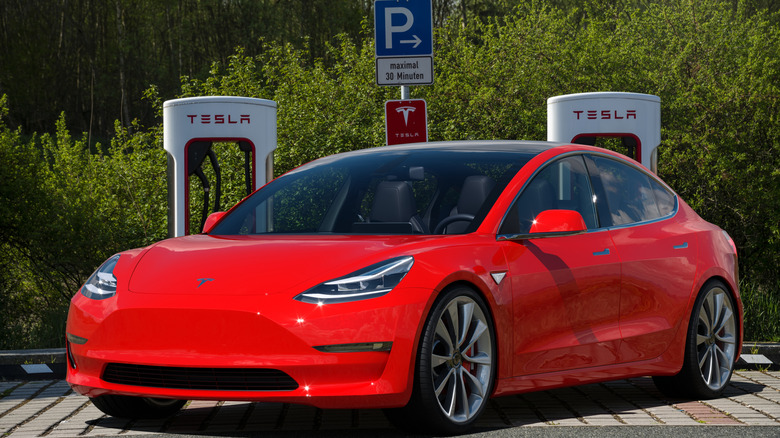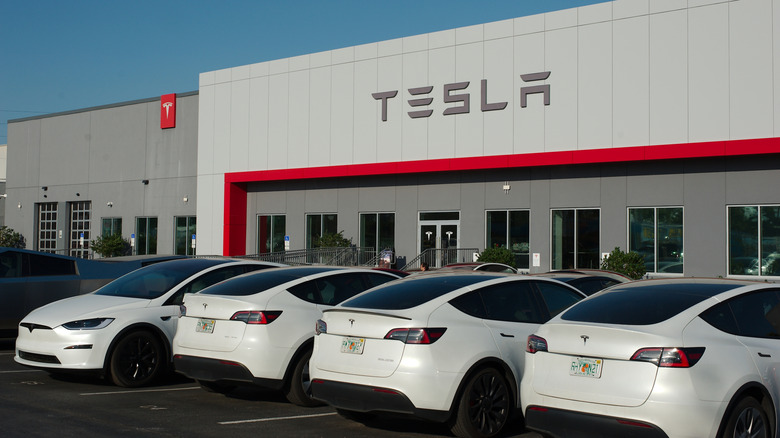Some Tesla Superchargers Aren't Approved For Use In California, Here's Why
The increasing popularity of electric vehicles (EVs), especially in California, has driven the demand for a robust network of charging stations. Tesla is well known for its high-tech electric vehicles and even has its own charging network, referred to as Superchargers. There are over 70,000 Tesla Superchargers around the world, and they're simple enough to use — even Fords and some other EVs can use Superchargers. Drivers just plug in their vehicle and can monitor charging progress on a smartphone app or the car's screen display.
However, policymakers in California want to usher in new regulations for the EV charging industry that align with the standard operations of the gas station industry. The concern is over the fact that, when drivers must pay money for EV charging, there needs to be a consistent way to measure how much the charge costs and why. The problem is that there's already a massive network of EV charging stations that don't meet these standards.
Some Tesla Superchargers go against a California law
Traditional gas pumps have stickers on them that guarantee they've been government inspected and meet certain standards. California plans to extend these rules to EV charging stations. While EV charging used to be a free service, with increasing popularity, there are now fees and payments associated with it. That caught the attention of the Division of Measurement Standards (DMS).
The DMS is concerned because there is no set standard at EV stations to measure how much charge is being dispensed, which could lead to drivers paying more while getting less. These stations vary in what they charge people and can include paying just for accessing them, paying for how much power is used, or paying for how long it takes to charge. That last one bothers measurement specialist Kevin Schnepp of the DMS, who stated to E&E News, "If someone was selling you something based on time, and they controlled the time that it was dispensed, would you trust them?" This may fall under California Business and Professions Code § 12500.5, which states, "It shall be unlawful to sell or use for commercial purposes any weight or measure, or any weighing, measuring, or counting instrument or device, of a type or design that has not first been so approved by the department."
How this impacts Tesla
Tesla Superchargers have a pay-per-use policy as well as additional fees, such as idle fees charged per minute if you leave your car at a station after it finishes charging. There are also congestion fees if a site is busy, which have a lot of gray area in their terms of service: "The congestion fee rate for each location, the site occupancy threshold, and the battery charge level where congestion fees may accrue may change from time to time."
Tesla released a statement in response to the DMS: "Charging an EV is a fundamentally different consumer experience than refueling a traditional gas powered automobile. Where a gas pump can complete a fill-up in a matter of minutes, [a] charging session can range anywhere from 30 minutes to several hours. ... Consumers do not stand at a charging station watching their battery fill up; instead, they plug in their vehicle and return when the charging session has been completed."
EV charging stations are expected to comply by 2033, though the companies that manage these stations complain that retrofitting their chargers will take time and cost huge amounts of money. Another blow dealt to this issue is the Trump administration's EPA freezing $5 billion in funds for an EV charging station initiative that would boost the nationwide charging network. Tesla itself was set to receive $31 million from those funds. If Tesla Superchargers are to meet new standards, they will have a massive project ahead of them.


